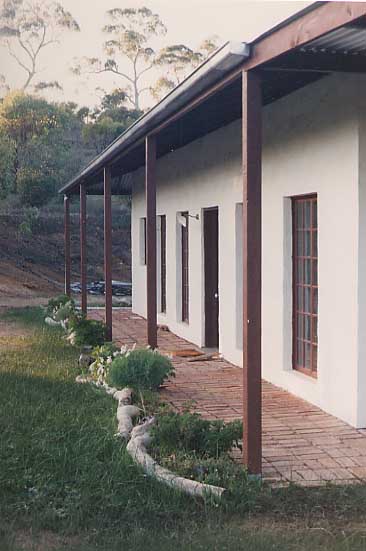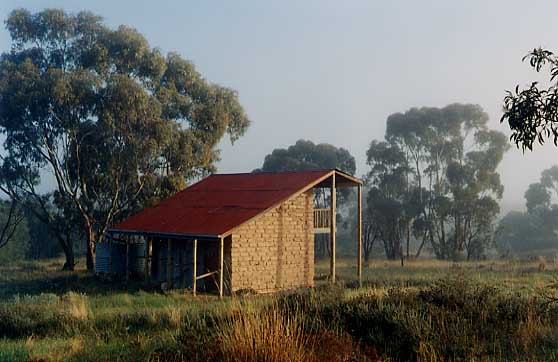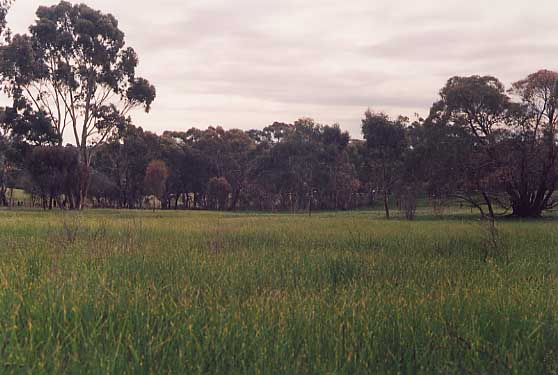In 1981 Maggie purchased one hundred acres of natural bushland in the heart of the Clare Valley in South Australia. She named it MAGGIES FARM after the Bob Dylan song. MAGGIE wanted to satisfy a desire to share in and care for some of Hughie's* own country and to satisfy a passion to build her own house.
The first task on her newly acquired vacant land was to build a garage in which she could live, or rather camp, until she could build a house.
A site was chosen for a garage and a future house. Two sites presented themselves. One near the road from Clare and one deep into the 100 acre block. The latter was chosen since the purpose of the building was to enjoy the serenity of the bush rather than the noise and dust of passing cars.
Erecting the garage was a hoot. All Maggie's mates came up in the Easter of 1981 to help her erect the relatively inexpensive double garage. It went up pretty easily - many hands make light work - and gave her a degree of satisfaction and a confidence which exceeded common sense. A 3,000 gallon rainwater tank was set next to the structure to provide water to the property.
She then frequented building sites where she talked to the blokes who were doing this work for a living. She was always surprised at how friendly they were and could not figure out whether they were just naturally helpful or whether they were amused by the young thirty year old who told them she was going to pour her own slab and build her own house. They always treated her decently were always quite happy to share their skills and knowledge.
Maggie lodged the plans with the Council in early 1982.
The foundations were dug by hand. Having set up the steel work herself, Maggie had a last minute panic attack and (wisely) decided to engage a concrete finisher to supervise the pour and float the slab.
Maggie built the walls out of besser brick - she was not a bricklayer - relatively quickly using a hand cement mixer to mix the mortar and two ladders and a plank as a scaffold. These bricks were later rendered in a traditional style. The roof was built without the aid of any electric tools partly because there was no power and partly because Maggie wanted to experience what the old settlers must have felt - in the middle of a seemingly "hostile" environment - with only a dray and horse.
Home made windows and the front and back doors were installed in September 1983 when Australia won the America' Cup. Maggie now moved out of the garage and into the shell of the house.
The house was wired for 240 volts. In fact, its first electric supply came from a solar cell installed on the roof which provided a 12 volt supply to a bank of lead acid batteries which provided lights at night.
A septic tank was installed.
The rain water tank was shifted from beside the garage to the side of the house. A further tank was installed on top of the hill. Water was collected in the bottom tank and pumped up to the top tank which in turn fed the house by gravity. There was much excitement when the tap was turned on for the first time and Maggie had running water.
A solar hot water service was mounted on the roof and Maggie now had not only running cold water but hot water as well. This seemed like a miracle.
Walls were plastered and ceilings erected. The wooden ceiling in the main room utilised car jacks to hold the wood in place while it was hidden nailed. Walls were painted. Second fix plumbing and carpentry was completed. Tiling was done. Kitchen Cupboards and furniture was built.

The house was completed in 1984. It had taken two years to build. It was a weekend retreat for Maggie's family for the next eight years.
1988 was the year of Australia's Bicentennery - two hundred years
of white settlement. With mud bricks very much in vogue, Maggie decided
to build a little something to "celebrate Australia's Bicentennial".
During the Depression of the 1890's and the Great Depression of 1929-35,
unemployed workers would roam the country seeking work. With their possessions
packed on their backs, they would wander from farm to farm seeking food
and shelter in exchange for work. They would stay in the open air and,
if they were lucky, in shearers' or workers' quarters on farming properties.
And so the concept of the Swaggies Hut was born, Maggie's monument to
the worker's huts of these periods.
Maggie started the backbreaking task of making one thousand mud bricks in 1987. In the hot January of 1988, and with the assistance of some friends, she built the little two storey mud brick house "for fun". It took just seventeen days. She had to move quickly because its walls were load bearing and she could not risk rain on the unprotected and uncovered walls. What a hoot!

Ken was the first swaggie to come to the hut. He has been there ever since. To this day Ken still startles those visitors to the Farm who dare to look in the windows of the hut.
In late October 1991, Maggie decided to share her piece of paradise with the world. She had the electricity connected - underground in order that no ugly poles would traverse the property - she slated the floors and refurbished the house with the fittings that guests would expect.
In March 1992, MAGGIES FARM opened for business.
Your accommodation is a modern building with all the advantages of a modern environmentally efficient and friendly design and yet looks and feels like an old building. Its furnishings are all in the old style. The combines effect has led many guests to ask how old the house is. They have been surprised when they have learnt it is a relatively new.
In 1999, Maggie built a second house on MAGGIES FARM. Named Hughie's (after Hughie of course) and located some four hundred metres and out of sight of your accommodation, it is permanently tenanted. These tenants will not impinge in any way on your privacy and
we ask you to respect theirs.
* Hughie is the god of all Australian Farmers - he who brings the sun
and the rain
